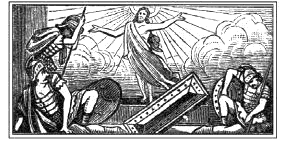
| Contents | Hymni Hymns |
Home |

The Church has had a long history of adding extra-scriptural sacred hymns to her Liturgy. The East was the first to include them in her liturgies from the very early centuries. The West at that time tended to remain with just Scriptural texts as the basis of their hymns. However, with the legalization of Christianity in the Roman Empire, that did not remain the case for long. Greats such as St. Ambrose (c. 339 - April 4 397) and St. Hilary of Poitiers (c. 310 - 367), the later had been formerly exiled to the East, brought the tradition of the East to the West. One of the earliest items was the ``Gloria in excelesis Deo,'' which was imported from the East. The Latin translation we have today is held to have been done by St. Hilary himself. Below is a sampling of just some of them. The Analectica Hymnica is a 50 volume collection of Latin hymns used down through the ages, which should give the reader some idea of the richness of hymns through the ages. The Hymns listed here are the ones that are associated with the various Liturgical Seasons and feasts. For hymns to a specific saint, look under the appropriate section. For example, hymns in honor of the Blessed Virgin Mary are shown in her section. Pope Urban VIII One item that needs some clarification is that Pope Urban VIII made extensive modifications to the Roman Breviary Hymns. Maffeo Barberini was born in Florence in April, 1568, elected Pope Urban VIII on 6 August, 1623, and died at Rome on 29 July, 1644. He has a number of calls to fame, one being that he was involved with the Galileo affair. He also was an active pope who carried out a number of reforms of the Church, some good, some not so good. One of his less successful reforms was his reform of the Roman Breviary. Pope Urban VIII was an excellent classical Latinist and felt that the hymns of the Roman Breviary needed to be reshaped into classical models. He was by no means the first nor the last to feel this way, but he has the distinction of being the Pope who actually carried out such an extensive revision of the hymns of the Roman Breviary into classical models. While a committee was appointed for the task, it is clear that the Pope personally oversaw the revision. Urban VIII was not content to leave alone the works of such great Latin Hymnodists such as Prudentius, Fortunatus, or even Ambrose, but instead molded their works and the works of others into classical forms. The revision of the hymn texts was approved by the Congregation of Rites on March 29, 1629 and on January 25, 1631, the revised Roman Breviary was authorized for publication. History and scholars have generally held that these revisions were very ill-advised. Indeed, those religious orders who were able to resist the revisions did so. Claiming the privilege of exemption granted by Pope Pius V because of the antiquity of their own Breviaries, the Dominicans, Benedictines, Cistercians, and Carthusians refused to adopt the revisions. Moreover, the revisions were never accepted at St. Peter's or the Lateran in Rome itself! This produced two distinct versions of the Latin hymnal that were to coexist for more than three hundred years. It was only until the recently that this was straightened out. With the adoption of the Liturgia Horarum to replace the older Breviarium Romanum, the current offices now use the restored texts. The older Breviarium Romanum, of course, still has his revisions. Due to the widespread use and familiarity many have with Urban's revised hymns in the Breviarium Romanum, I have tried to indicate his revisions as footnotes to the text of the original hymns and thereby hopefully clear up some of the confusion that lingers today. |
- Tempus Per Annum
Ordinary Time- Adventus
Advent- Navtivitas
Christmas Season- Epiphania
Epiphany- Tempus Quadragesimae
Lent- Sacruum Triduum Paschale Passionis et Resurrectionis Domini
The Triduum- Tempus Paschale
Eastertide- Pentecoste
Pentecost- Corpus Christi
Feast of Corpus Christi- Omnes Sancti et Omnes Animae
All Saints and All Souls- Hymni Alii
Other Hymns
<- Prev |
Next-> |
